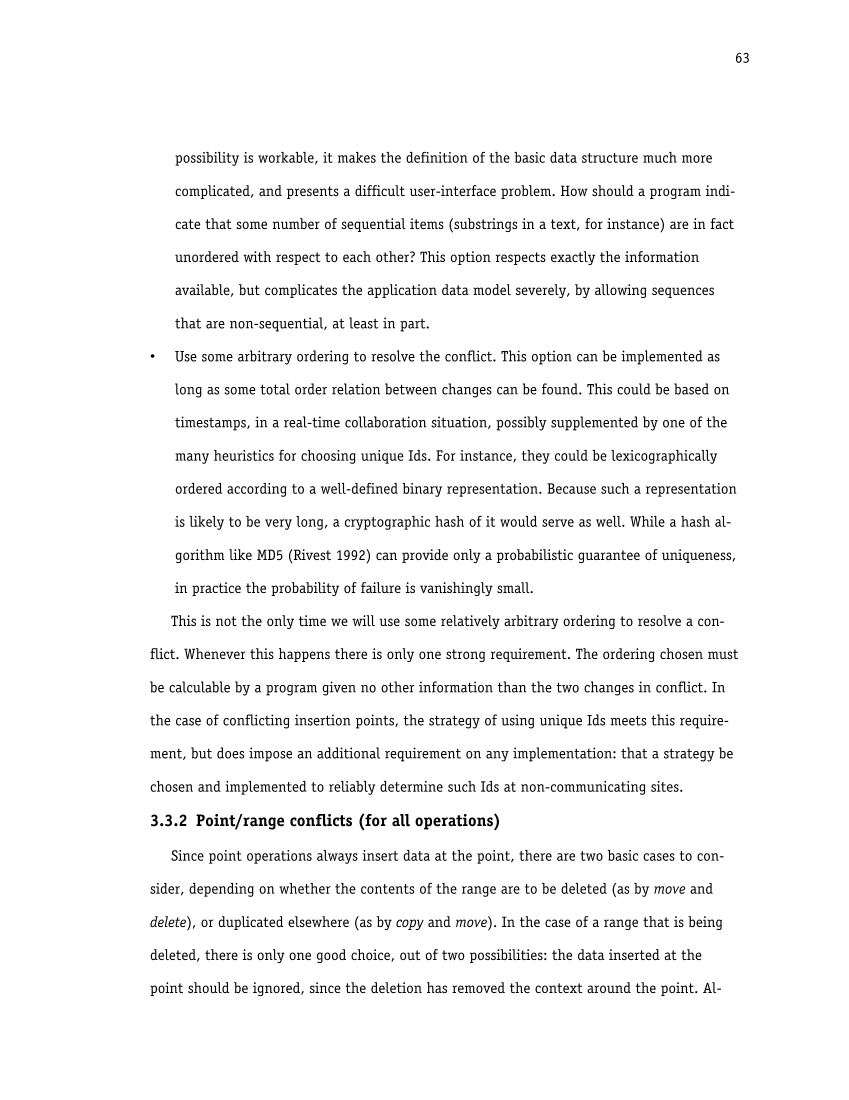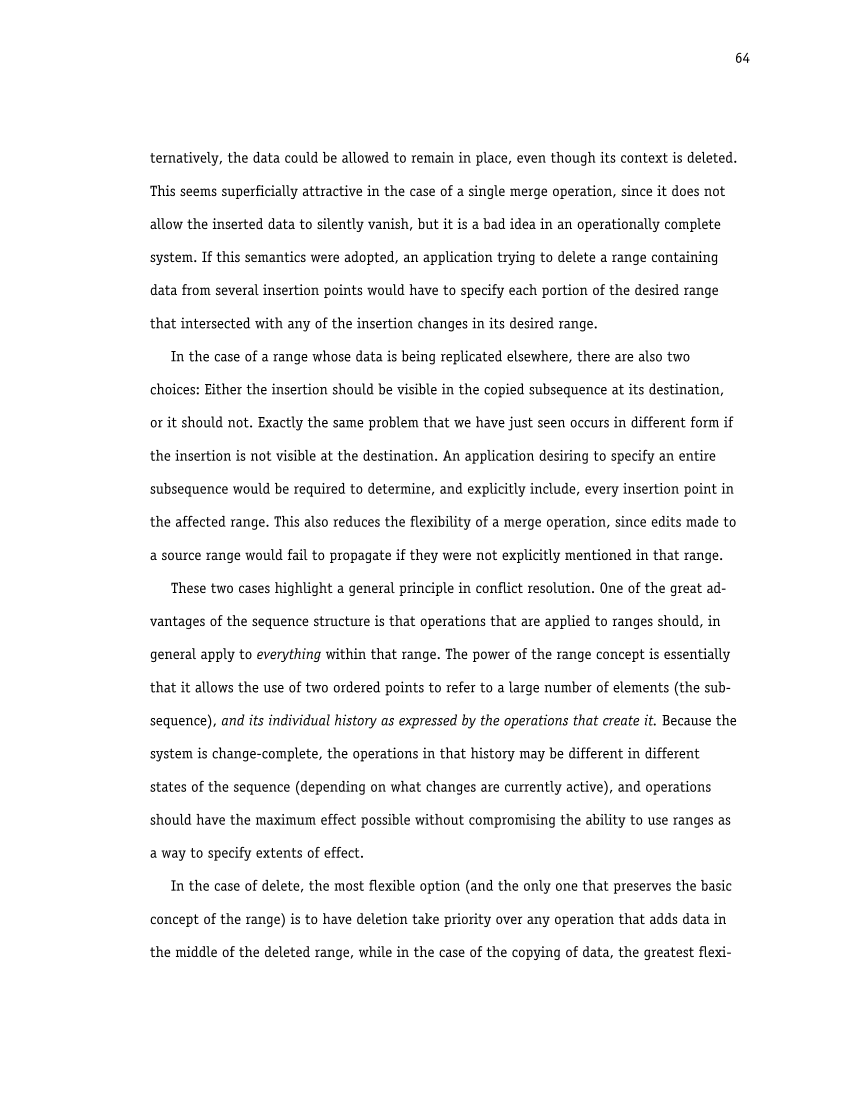63
possibility�is�workable,�it�makes�the�definition�of�the�basic�data�structure�much�more
complicated,�and�presents�a�difficult�user-interface�problem.�How�should�a�program�indi-
cate�that�some�number�of�sequential�items�(substrings�in�a�text,�for�instance)�are�in�fact
unordered�with�respect�to�each�other?�This�option�respects�exactly�the�information
available,�but�complicates�the�application�data�model�severely,�by�allowing�sequences
that�are�non-sequential,�at�least�in�part.
• Use�some�arbitrary�ordering�to�resolve�the�conflict.�This�option�can�be�implemented�as
long�as�some�total�order�relation�between�changes�can�be�found.�This�could�be�based�on
timestamps,�in�a�real-time�collaboration�situation,�possibly�supplemented�by�one�of�the
many�heuristics�for�choosing�unique�Ids.�For�instance,�they�could�be�lexicographically
ordered�according�to�a�well-defined�binary�representation.�Because�such�a�representation
is�likely�to�be�very�long,�a�cryptographic�hash�of�it�would�serve�as�well.�While�a�hash�al-
gorithm�like�MD5�(Rivest�1992)�can�provide�only�a�probabilistic�guarantee�of�uniqueness,
in�practice�the�probability�of�failure�is�vanishingly�small.
This�is�not�the�only�time�we�will�use�some�relatively�arbitrary�ordering�to�resolve�a�con-
flict.�Whenever�this�happens�there�is�only�one�strong�requirement.�The�ordering�chosen�must
be�calculable�by�a�program�given�no�other�information�than�the�two�changes�in�conflict.�In
the�case�of�conflicting�insertion�points,�the�strategy�of�using�unique�Ids�meets�this�require-
ment,�but�does�impose�an�additional�requirement�on�any�implementation:�that�a�strategy�be
chosen�and�implemented�to�reliably�determine�such�Ids�at�non-communicating�sites.
3.3.2 Point/range�conflicts�(for�all�operations)
Since�point�operations�always�insert�data�at�the�point,�there�are�two�basic�cases�to�con-
sider,�depending�on�whether�the�contents�of�the�range�are�to�be�deleted�(as�by�moveand
delete),�or�duplicated�elsewhere�(as�bycopyandmove).�In�the�case�of�a�range�that�is�being
deleted,�there�is�only�one�good�choice,�out�of�two�possibilities:�the�data�inserted�at�the
point�should�be�ignored,�since�the�deletion�has�removed�the�context�around�the�point.�Al-
possibility�is�workable,�it�makes�the�definition�of�the�basic�data�structure�much�more
complicated,�and�presents�a�difficult�user-interface�problem.�How�should�a�program�indi-
cate�that�some�number�of�sequential�items�(substrings�in�a�text,�for�instance)�are�in�fact
unordered�with�respect�to�each�other?�This�option�respects�exactly�the�information
available,�but�complicates�the�application�data�model�severely,�by�allowing�sequences
that�are�non-sequential,�at�least�in�part.
• Use�some�arbitrary�ordering�to�resolve�the�conflict.�This�option�can�be�implemented�as
long�as�some�total�order�relation�between�changes�can�be�found.�This�could�be�based�on
timestamps,�in�a�real-time�collaboration�situation,�possibly�supplemented�by�one�of�the
many�heuristics�for�choosing�unique�Ids.�For�instance,�they�could�be�lexicographically
ordered�according�to�a�well-defined�binary�representation.�Because�such�a�representation
is�likely�to�be�very�long,�a�cryptographic�hash�of�it�would�serve�as�well.�While�a�hash�al-
gorithm�like�MD5�(Rivest�1992)�can�provide�only�a�probabilistic�guarantee�of�uniqueness,
in�practice�the�probability�of�failure�is�vanishingly�small.
This�is�not�the�only�time�we�will�use�some�relatively�arbitrary�ordering�to�resolve�a�con-
flict.�Whenever�this�happens�there�is�only�one�strong�requirement.�The�ordering�chosen�must
be�calculable�by�a�program�given�no�other�information�than�the�two�changes�in�conflict.�In
the�case�of�conflicting�insertion�points,�the�strategy�of�using�unique�Ids�meets�this�require-
ment,�but�does�impose�an�additional�requirement�on�any�implementation:�that�a�strategy�be
chosen�and�implemented�to�reliably�determine�such�Ids�at�non-communicating�sites.
3.3.2 Point/range�conflicts�(for�all�operations)
Since�point�operations�always�insert�data�at�the�point,�there�are�two�basic�cases�to�con-
sider,�depending�on�whether�the�contents�of�the�range�are�to�be�deleted�(as�by�moveand
delete),�or�duplicated�elsewhere�(as�bycopyandmove).�In�the�case�of�a�range�that�is�being
deleted,�there�is�only�one�good�choice,�out�of�two�possibilities:�the�data�inserted�at�the
point�should�be�ignored,�since�the�deletion�has�removed�the�context�around�the�point.�Al-





























































































































































































